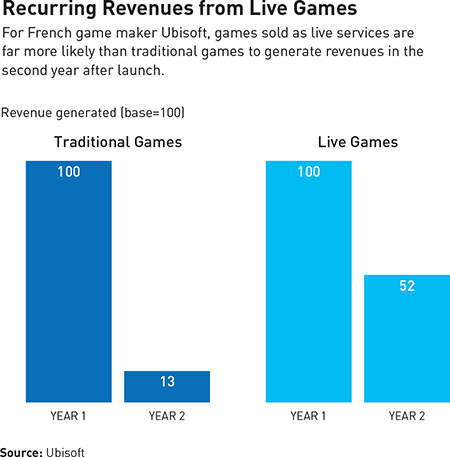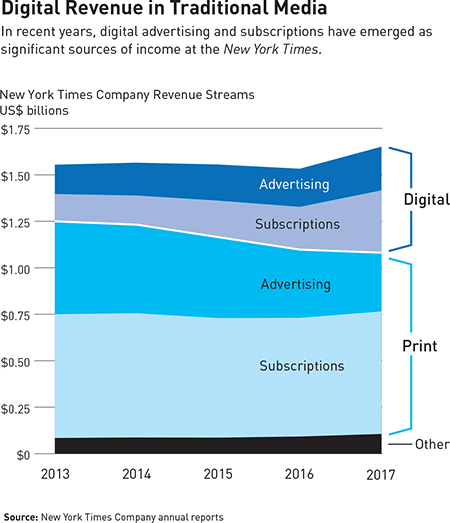The Revenue Stream Revolution in Entertainment and Media
Developing new sources of income is a vital strategic imperative.
Digitization has permanently reshaped the global entertainment and media (E&M) ecosystem. Content has become more immersive and available on demand. Digital platforms have proliferated, creating more direct and personalized distribution. The competition for user engagement and spending has never been more brutal. All these developments have significantly disrupted the flow of E&M revenues. Gone are the days when TV networks, film studios, or companies of any kind could thrive on one, two, or even three reliable revenue sources. Today, profitable growth increasingly depends on having five, six, or even more revenue streams — an often fluid portfolio of bets on businesses and products that extend beyond traditional sources of monetization.
Just look around. Companies in every E&M sector are launching live events and podcasts, creating subscription offerings, producing video for consumers and brands, and expanding e-commerce and product licensing efforts. TV networks and film studios are developing streaming video services. Sports leagues and video game companies are converging on e-sports. Many are prioritizing new advertising products. Some of the most ambitious players are expanding globally, building new revenue streams in new geographies.
Many successful E&M companies have always benefited from multiple revenue streams: carriage fees and advertising for pay-TV networks; tickets and popcorn for cinema owners; single-copy sales, subscriptions, and advertising for magazine and newspaper publishers. What is different now is a sense of urgency driven by a more arid monetization environment. Traditional sources of advertising and subscription revenues are drying up, and the largest digital platforms are absorbing much of the digital advertising growth. Consumption and spending habits are evolving with remarkable speed. Meanwhile, many companies remain overly reliant on legacy media revenue streams whose current is ebbing. Absent significant new sources of revenue growth, the strategic options for these companies will inevitably narrow to continued rounds of cost cutting and preparation for their eventual consolidation.
Amid these challenges, some are succeeding in developing promising new revenue streams — in areas such as subscription services, digital microtransactions, membership, consumer products, live events, and advanced advertising. They are constructing portfolios of connected and complementary experiences that tap into the commercial potential of their most engaged users: their fans. The logic makes strategic sense. Fans watch more, listen more, participate more, share more, advocate more, and create more. Most important, fans spend more, and they are more compelling for advertisers (see “How to Make Entertainment and Media Businesses ‘Fan’-tastic,” by Christopher Vollmer, s+b, May 8, 2017).
Take video games. Between 2012 and 2017, video games expanded faster than any other major content sector: music, film, newspapers, magazines, books, and pay-TV. The sector is projected to grow 28 percent between 2018 and 2022, according to PwC’s Global Entertainment & Media Outlook 2018–2022. Game publishers such as Electronic Arts (EA), Activision, and Take-Two Interactive have moved from a single stream — the one-time sales of packaged media — to a multiple-stream revenue model. Games are now marketed as digital live services, which offer the potential for content updates and in-game micropurchases of items that enhance player performance and personalize game play. At EA, 35 percent of the players of Madden and FIFA, the company’s two most valuable franchises, spend money on in-game purchases associated with its Ultimate Team game mode, where players manage a fantasy team and improve their squad by purchasing better players. Live services accounted for about 40 percent of EA’s US$5 billion in FY 2018 revenue, and were up 30 percent for the year. The trajectory is similar for both Activision and Take-Two Interactive. Success in this area has emboldened game publishers to extend their intellectual property (IP) and fan bases into e-sports, film and TV properties, and consumer products, all of which are target-rich opportunities that can create additional revenue streams.
Yet developing multiple revenue streams remains a challenge for many E&M companies, especially those accustomed to meeting their financial goals on the basis of a few dominant revenue sources. Many E&M organizations are hamstrung by operational silos, antiquated incentives, and behavioral inertia. New revenue growth efforts are further stymied by insufficient alignment, weak coordination, and slower-than-desired execution. Some companies lack the consumer marketing acumen to acquire and retain users in a direct-to-consumer relationship. Others have yet to invest in the necessary analytics expertise. Finally, too many executives get caught up in the hype cycle, swarming the same opportunities like bees around a hive — remember the collective “pivot to video” among digital publishers?
Building new revenue streams requires making significant changes to the strategy, operating model, and culture of E&M companies. The good news is that, as described below, a series of models offer promise, and it is clear what enabling capabilities need to be built and developed in order to implement them.
Model Behavior
Various revenue-generating models are emerging for creating new fan-focused revenue streams from around the E&M world. The most prominent of these models that are gaining traction are detailed below.
THE PLATFORM: Maximize distribution reach by monetizing existing core brands, products, and intellectual property through new channels and platforms, either owned and operated or accessed via partners. CBS All Access, the television network’s subscription video service (offered with limited commercials for $5.99 per month or commercial-free for $9.99 per month), debuted in the fall of 2014. Powered by exclusive original series such as Star Trek: Discovery and The Good Fight (a spin-off of the popular CBS Network series The Good Wife) that target specific fan communities as well as a live feed of the CBS Network and Sunday NFL games, the video service has grown to 2.5 million subscribers, adding approximately 500,000 in the last year. This performance suggests a new revenue stream of at least $180 million in video subscriptions on a run rate basis (assuming all 2.5 million subscribers pay $5.99 per month).
CBS is betting it can attract more fans to become CBS All Access subscribers through expanded digital distribution. It is starting with Amazon Channels, the video marketplace offering premium streaming services to Amazon Prime subscribers. CBS expanded its Amazon relationship to include a multi-country licensing deal that enables Amazon Prime to show The Good Fight in selected global markets, producing yet another revenue stream. Finally, CBS has launched free ad-supported streaming services, CBSN and CBS Sports HQ, to target younger news and sports fans who can, over time, be converted into paying All Access subscribers.
THE TARGETER: Develop revenue streams from new ad products that connect brands to fan communities, and create more compelling experiences for users and marketers. Nielsen research shows that innovative advertising products can increase consumer engagement by as much as 20 percent. Since its 2015 acquisition by 21st Century Fox, National Geographic (NatGeo) has applied its iconic strengths in visual storytelling to areas in which user engagement is growing: social media and video. NatGeo has amassed more than 350 million social media connections, including a market-leading presence on Instagram of 87 million followers. NatGeo has capitalized on these connections by creating the National Geographic Further Community, a network aggregating NatGeo’s digital channels, its roster of premium content creators, and like-minded partners such as Mashable, theSkimm, and Atlas Obscura. In a digital ad market that rewards both scale and innovation, the Further Community is NatGeo’s pathway to moving beyond traditional display and creating a new advertising-focused revenue stream using native content, custom sponsorships, social e-commerce, and other new advertising products.
NatGeo has also moved to coproduce programming with marketers that fit well with the company’s brand and fan ethos. In 2017, NatGeo collaborated with Nike on Breaking2, a documentary chronicling how a team of distance runners and scientists from the Nike Sport Research Lab attempted to run a sub-two-hour marathon. This 55-minute documentary ran ad-free, sponsored by Nike — a new partner to NatGeo and one not previously considered a high-potential target — on the National Geographic Channel. Breaking2 also achieved a sizable presence in social media. Thirteen million users watched the event live on Twitter, and more than 2 million users had viewed the documentary on NatGeo’s YouTube channel as of April 2018.
Sky, a pan-European entertainment company, has prioritized advanced advertising products as a new revenue stream. Through Sky’s AdSmart platform, addressable households (those within a defined or targeted audience) receive different ads during the same TV programming; ads are based on viewers’ demographics, location, shopping habits, and behavioral attributes. Sky has created more than 1,200 audience segments — examples include “sports car fans” and “luxury travelers” — that advertisers can target to ensure that their media buys are more effective. In exchange for this precision, Sky charges a significant price premium (up to eight times as much) for AdSmart ad units compared with rates for non-addressable TV inventory. What’s more, Sky has used AdSmart to attract a new class of advertisers: 74 percent of AdSmart customers are either new to television or new to Sky.
THE TRANSACTOR: Create revenue opportunities from closing the loop between driving user engagement and instigating commerce activity. Video game companies appear to have cracked the code on monetizing digital engagement through direct-to-user microtransactions. France’s Ubisoft, like its peers Activision, EA, and Take-Two, has shifted its strategy from releasing annual blockbusters to reinventing franchises such as Assassin’s Creed and Tom Clancy’s Rainbow Six Siege as digital live services. For Ubisoft, games as services, wherein players purchase digital content on a recurring basis, are four times as effective at retaining monetization in their second year after the purchase as traditional packaged media games (see “Recurring Revenues from Live Games”). In Assassin’s Creed Origins, these purchasable digital items include gear such as a $4.99 “unicorn mount,” a $2.50 “lord of bones predator bow,” and $2 maps that provide time-saving shortcuts. These in-game microtransactions, or what Ubisoft refers to as “recurring player investments,” grew 87 percent in fiscal year 2018, and now represent 27 percent of total company revenue.
Video game publishers believe new approaches to microtransactions will lead to even greater revenue per user. Mimicking techniques perfected by the airline industry to maximize ticket revenue from seat sales, game publishers are adjusting prices dynamically for microtransaction items based on user demand. They are also applying machine learning to analyze player context and determine where, when, and how to best merchandise and promote items to users in-game.
THE OMNI-BRAND: Extend a branded media property into new revenue streams through physical experiences and products. BuzzFeed, which grew to prominence as an ad-supported digital publisher focused on news and memes, has expanded into content for interest areas such as food. For example, Tasty, BuzzFeed’s foodie brand, has established a large social media community on Instagram (17 million followers), Facebook (94 million likes), and YouTube (6 million subscribers). BuzzFeed increasingly views the Tasty brand as a fan platform that can support new revenue streams in e-commerce and physical product sales. Its eponymous cookbook, published in November 2017, was a best-seller, having sold more than 100,000 copies by early January 2018. Building on the success of its Tasty One Top, a Bluetooth-enabled induction cooktop, BuzzFeed has struck an exclusive partnership with Walmart to sell an expanded line of Tasty kitchen tools both on Walmart.com and in the company’s physical stores — from a $7.97 three-pack of peelers to a $99 11-piece Tasty cookware set.
Video game companies appear to have cracked the code on monetizing digital engagement through direct-to-user microtransactions.
Barstool Sports, a fast-growing U.S. digital sports publisher whose devoted fans are referred to as “stoolies,” generates about 30 percent of its revenues from branded merchandise such as $25 T-shirts, $45 hoodies, $30 baseball hats, and $15 coffee mugs, many emblazoned with unique mottos such as “Saturdays Are for the Boys” and “Barstool vs. the World.” Merchandise sales are also Barstool’s fastest-growing revenue stream, expanding 400 percent year-over-year. Encouraged by its ability to sell products to its enthusiastic fans, Barstool is developing a live events and pay-per-view revenue stream — the company recently purchased the Rough N Rowdy Brawl amateur boxing competition — as well as more commercial licensing relationships that may eventually include a chain of Barstool bars. Large companies are also seeking to create new revenue streams in consumer products from their IP, such as Tencent with its hit mobile game Honor of Kings.
THE MEMBER: Develop premium media experiences and other benefits, products, and services that are accessible only to those users who are willing to pay for them. The New York Times Company has experienced declines in print advertising and circulation, and its digital advertising growth has been unable to make up the difference. The company has prioritized developing new streams involving digital subscriptions aimed at its most engaged readers. The once-porous paywall now permits casual users to read just five free articles per month. The Times markets a “basic” digital subscription for $16 per month, which provides unlimited access to its digital content. And for $27 per month, subscribers have “all access” to the Times’ digital content as well as its popular crossword and cooking apps, plus one shareable bonus subscription.
The number of digital subscribers soared from 910,000 in 2014 to 2.64 million in 2017, representing an annualized growth rate of 42.7 percent. In the fourth quarter of 2017, paid digital subscriptions represented 20 percent of total company revenues, up from 11 percent in 2014 (see “Digital Revenue in Traditional Media”). Users are subscribing to gain access to Times content, but also to express solidarity with the Times’ mission and affinity with its reader community. This engaged subscriber fan base — which represents just 3 percent of the 90 million people who visit Times digital properties each month — has become an attractive monetization target for the company’s expanding portfolio of consumer offerings and reader-focused services in travel (New York Times Journeys), product recommendations (Wirecutter, a site acquired in 2016), education (the School of the New York Times), events (Times Talks, New York Times conferences, and subscriber events), and clubs (New York Times Wine Club, New York Times Film Club). Revenue streams in affiliate referrals, e-commerce, and live events are part of the company’s rapidly growing “other revenue” segment, which rose 16 percent in 2017 and now represents 6 percent of total company revenue.
Schibsted, a Scandinavian media company with leading newspapers in Sweden and Norway, has aggressively converted ad-supported readers into digital subscriber–members. The company currently has about 590,000 subscribers, and has increased its digital subscription revenues by 61 percent since 2015. Most news, entertainment, and lifestyle content is free to Schibsted’s users, supported by advertising. Schibsted has developed a winning member proposition in which more robust sports coverage, in-depth features, and other benefits are available only to subscribers. The company has experimented with other bundles to convert free users to members. Digital subscribers to Aftonbladet, a Swedish newspaper, also receive access to a streaming video service, SF Anytime, via a partnership with Bonnier.
THE PROSPECTOR: Create revenue streams in new entertainment and media markets where business models and fan experiences are not yet fully established. Video game publishers and sports entertainment entities increasingly view e-sports as their next big revenue growth engine (see “Video Gaming Levels Up into a Sport,” by Bob Woods). Tencent’s Riot Games has introduced a franchise structure for its North American League of Legends Championship Series (NA LCS) to encourage higher growth and a more stable ecosystem. Activision has formed the Overwatch League (OWL) — also supported by city-based franchises — inspired by its namesake multiplayer game. EA is developing e-sports competitions for both its Madden and FIFA franchises. And Take-Two Interactive and the NBA have teamed up to form the NBA 2K e-sports league.
Stockholm-based MTG (Modern Times Group) has prioritized expansion into e-sports as the company transforms from a traditional broadcaster into a digital entertainment group. As millennials’ TV consumption of traditional sports properties such as the English Premier League and Formula One auto racing began to wane, the company bet early and big on the converging trends of video gaming, video streaming, social media, and sports fan culture. In late 2015, MTG acquired a majority position in ESL, one of the world’s largest operators of e-sports leagues and tournaments. The acquisition of DreamHack, an e-sports events company, soon followed. In 2017, MTG’s e-sports business contributed 1.4 billion SEK (US$166.8 million) in revenues to MTG, about 8 percent of the company’s total, growing 36 percent from 2016 to 2017. The company expects revenue streams from sponsorships, live events, merchandise, advertising, and media rights to increase significantly as the e-sports sector further professionalizes and becomes more mainstream. In 2018, MTG announced its intention to split into two companies, one focused on e-sports, online gaming, and digital video, and another focused on broadcasting, digital communication, and content production.
THE GLOBALIZER: Expand addressable revenue streams by entering new geographic markets. At the end of 2012, Netflix had a presence in 40 countries and about 6.1 million streaming subscribers outside the United States, representing about 18 percent of its total subscribers. But after an aggressive globalization push — Netflix is now available in 190 countries — its international subscribers grew 10-fold, to 62.8 million by the end of 2017, and now exceed the company’s 54.8 million domestic subscribers. Between the fourth quarter of 2015 and the fourth quarter of 2017, international revenues nearly tripled, expanding from $566 million to $1.55 billion.
Many pieces came together to support Netflix’s rapid international expansion. Distribution partnerships with TV operators and ISPs had to be secured. Huge volumes of on-demand video content had to be procured and translated effectively. Local billing relationships in local languages had to be established. But Netflix also departed from conventional content internationalization strategies that emphasized demographics and cultural distinctions such as language, and instead focused on identifying and targeting global communities of fans.
Rather than acquiring and developing shows that would appeal only to, say, German viewers, Netflix set out to curate content, in any language, that would appeal to the nearly 2,000 “taste communities” it identified during the course of its global rollout. Taste communities are groups of subscribers around the world who are fans of certain types of content, regardless of where they live. The company described it this way: “We believe that a Jessica Jones fan in Argentina has more in common with a Jessica Jones fan in Germany than the House of Cards viewer next door.” Such efforts have allowed Netflix to get more mileage out of its 80-odd non-English-language originals. For example, about 90 percent of the viewership of Dark, a science fiction mystery series that was Netflix’s first original production for Germany, has come from outside Germany. By innovatively combining capabilities involving user segmentation, content development, metadata, content discovery, and product personalization, Netflix has redefined how to target and engage fans in granular ways and then monetize those communities on a global scale.
The Right Capabilities
There are many different approaches to building revenue streams, but a series of common capabilities underpin the success of such efforts. Whether it is National Geographic’s Instagram presence, the New York Times’ journalism, EA’s FIFA, or MTG’s e-sports competitions, a compelling fan-centric offering begins with engaging content. But content and distribution expertise must be paired with other capabilities in data analytics, in acquisition and retention mechanisms, in experience development, and in strategic revenue management.
Data analytics and insights. First-party data has emerged as perhaps the most valuable asset for E&M companies as they seek new revenue streams. To bolster existing streams, ad-supported E&M businesses have to prove that their users are differentiated and that their ad products deserve a premium and a greater share of marketers’ budgets. And as concerns grow about accuracy and trust in the entertainment and marketing ecosystem, the industry considers first-party data sourced from E&M companies more accurate and reliable than what is available from third-party providers.
Too many companies still lack the data management expertise to fully connect, integrate, synthesize, and activate the first-party data derived from their content offerings, advertising products, and user relationships. Some lack the metrics, processes, and discipline to generate robust insights into user intentions. By increasing their focus on registration (examples include digital subscription products and video games in which players must create a unique personal ID before they play), companies can develop deeper, more proprietary insights into demographics, interests, behaviors, and devices used.
Companies also can create valuable first-party data from direct interactions with fans. Video game publishers such as Ubisoft and EA have built multiple channels so that they can “listen” to fans directly via social media, discussion forums, public and private beta versions, live events, and customer support channels. Aided by this granular feedback, video game companies can strengthen their operations in the areas they know will affect key performance indicators, such as daily average users, time spent per visit, return and churn rates, player satisfaction, and net promoter scores.
User acquisition and fan retention. To build new revenue streams effectively, E&M companies must adopt new approaches to acquiring, retaining, and rewarding fans that are predicated on applying enhanced analytics capabilities. News Corporation’s Wall Street Journal (WSJ) and Schibsted have developed prediction models that determine how likely it is that an ad-supported user can be converted to a subscriber. After analyzing first-party signals such as the frequency of visits, device used, a user’s location, day of the week, and other demographic and browsing-based insights, the company assigns each user a “propensity score” that indicates his or her likelihood to subscribe (high, medium, or low). The WSJ and Schibsted then tailor the user experience (by, for example, enticing high potentials with greater content access before they hit the paywall) and acquisition promotions (emails curated with user-relevant content and special subscription offers) to encourage conversion. Schibsted has said its prediction model has significantly improved the effectiveness of its audience acquisition efforts, identifying readers who are three to five times as likely as average users to subscribe.
To keep fans of Marvel franchises such as Guardians of the Galaxy and the Avengers active and engaged between new films and other product releases, Disney has created a fan loyalty program, dubbed Marvel Insider. Insiders earn points as they interact on social media, purchase comics, watch videos and trailers, play mobile games, listen to podcasts, and complete fan surveys. As fans gain points, they get access to Marvel Insider–only rewards and events. In return, Disney establishes a registered relationship (collecting more first-party data) with its most loyal fans and a channel for learning what is most important to them, today and tomorrow. Since the company launched Marvel Insider in late 2016, approximately 80 percent of insiders have earned points post-registration, and they are spending more than non-insiders in areas such as mobile games.
User experience. E&M companies have to assume responsibility for, and, in many cases, ownership of the user’s overall experience. This means taking an end-to-end view of what drives user engagement and loyalty — before, during, and after consumption or purchase as well as across content, distribution, and technology. The winning companies will excel as general contractors, orchestrators, and integrators that ensure that an end-to-end user experience meets the needs and expectations of fans. Whether they construct it all themselves or piece it together via acquisitions and partnerships, they must develop user experiences that (1) activate fan interests and passions in new ways that reinforce their existing relationships, (2) create a “wow” factor that inspires fans to share, energizing both existing fans and new ones, and (3) improve over time by incorporating fan feedback and becoming more personalized.
Manchester United (ManU) is one of the world’s most successful sports franchises, on and off the pitch. In 2017, ManU generated revenues of £581 million (US$818 million), driven by several powerful streams: live match-day attendance, linear TV rights, and commercial activities such as sponsorships and merchandise. But ManU has recognized that today’s revenue streams, which are primarily fueled by television rights, will not likely be tomorrow’s growth engines. The club’s fan base has globalized rapidly across Asia, the Middle East, Africa, and the Americas. Most of these fans will never set foot in the Old Trafford stadium. For younger fans in every geography, traditional TV is playing a less central role in media consumption. For ManU, converting today’s trends into tomorrow’s revenue streams increasingly depends on building capabilities that enable the club to take more ownership of its media rights and its fan experiences.
Although ManU’s direct-to-fan revenues are small today, they are growing in strategic importance. In the last two years, ManU has prioritized investments in social and mobile media as well as in an expanded in-house media and content operation. The club’s owned and operated media portfolio includes a large social media presence with about 150 million connections; a CRM database with more than 45 million records; and MUTV, a mobile app and over-the-top (OTT) video subscription service that retails for $2.99 per month in the U.S. and has subscribers in 140 countries. ManU’s social footprint on Twitter and Facebook is actively funneling fans to MUTV where they can be converted to subscribers. MUTV has increased its emphasis on exclusive content, focusing on original productions, documentaries, and pre-match coverage. The video service is connecting with fans in global markets — 40 percent of subscribers are in the United States. The average age of an MUTV subscriber is 32. With MUTV at the center, ManU is building a digital media ecosystem in which multiple revenue streams will flow: direct-to-consumer subscriptions, digital advertising and sponsorships, and e-commerce.
Strategic revenue management. Orchestrating a multi-revenue-stream business around fans requires strong top-down leadership from executives with oversight for the entirety of a company’s monetization efforts. They must understand revenue trends for key brands, user segments, and initiatives; competitive dynamics that affect the addressable market; and drivers of conversion, churn, and lifetime value. They have the decision rights to optimize existing businesses and green-light new revenue opportunities. They are willing to have tough discussions internally about the trade-offs and expectations associated with new revenue streams.
As digital engagement grows, cross-functional collaboration will be essential to defining the market, product, and technology requirements associated with creating winning user experiences. Companies must bring together functions involving content, product, audience development, business and partnership development, sales, and operations in more flexible and integrated ways. In startups, this can be easy. In established companies, achieving the required level of sustained teaming, functional alignment, and ownership can be much harder. Standing up smaller, dedicated teams with clear performance indicators outside the traditional revenue streams can be a solution to these challenges.
Fortitude. There is a final capability, or rather a mind-set, required to develop revenue streams: patience. Many E&M companies have increased their focus on these streams simply out of necessity. The current trajectory of media consumption and spending behaviors effectively gives them no compelling alternative. But building an E&M business with multiple complementary and connected revenue streams does not happen easily or quickly. Sustained focus, commitment, and resources are critical ingredients in new revenue stream success.
For many companies, developing these streams successfully requires important changes to their business strategy, operating models, culture, and talent. Leadership teams need to ask themselves important questions related to the dynamics of their businesses, products, and brands. Do we really know our fans? How can we build a bigger fan base? Which revenue streams and revenue-generating models are the right ones for us? And do we have the necessary capabilities in data, acquisition and retention, user experience, and strategic revenue management to accelerate revenue generation?
As E&M value shifts from user attention to fan loyalty, the companies that can answer these questions confidently and move their organizations decisively toward supporting a larger portfolio of revenue streams will emerge as the winners. The time to do so is now.
A Prime Platform
At the end of 2017, Amazon had an estimated 90 million Prime members, users who spend US$99 per year for a bundle of free two-day shipping, Amazon Prime Video, Amazon Music, and assorted other benefits. These members, who spend nearly twice as much as non-Prime customers, according to a 2017 study by Consumer Intelligence Research Partners (CIRP), are essentially Amazon’s fan base. The growth of Prime membership has opened up a new stream of revenues for Amazon: advertising.
Amazon has exactly what many other marketers wish they had as they seek their ideal consumers. Amazon knows what brands users want thanks to their product search and purchase history. It has insight into what drives user engagement and user interests through Prime Video. Amazon can personalize a user’s e-commerce experience with actual conversion and transaction data. And it is building capabilities in voice interfaces and artificial intelligence that will further influence how brands connect with shoppers. The upshot: JPMorgan Chase estimated that Amazon’s advertising revenues were $4.5 billion in 2017, a tiny chunk of overall revenues but already a meaningful and profitable sum. Although Amazon does not break out advertising results, its fourth-quarter 2017 “other” revenue, which is where ad revenue is recognized, was $1.7 billion, up 62 percent from the same quarter the prior year.
PwC Global Entertainment & Media Outlook 2018–2022: A comprehensive source of advertising and consumer spending data.
Author profile:
- Christopher Vollmer is the technology, media, and telecommunications (TMT) Americas leader for PwC and the global TMT leader for Strategy&, PwC’s strategy consulting business. He focuses on growth strategy, capability building, and business transformation for leading media and technology companies. Based in New York, he is a principal with PwC US.
- PwC US director Kristina Bennin also contributed to this article.







